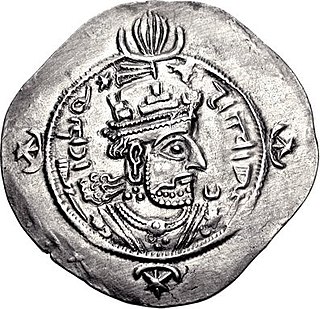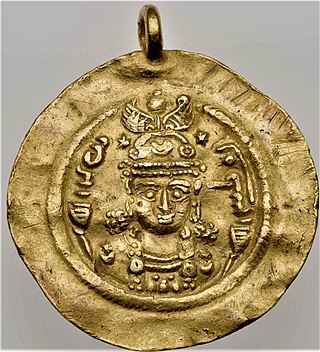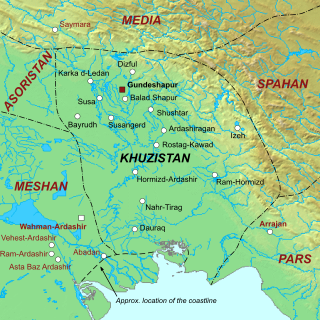
Kavad II was the Sasanian King of Kings of Iran briefly in 628.

Khosrow II, commonly known as Khosrow Parviz, is considered to be the last great Sasanian king (shah) of Iran, ruling from 590 to 628, with an interruption of one year.

Bahram IV, was the Sasanian King of Kings of Iran from 388 to 399. He was likely the son and successor of Shapur III.

Ardashir III was the Sasanian King of Kings of Iran from 6 September 628 to 27 April 630.

Shahrbaraz, was shah (king) of the Sasanian Empire from 27 April 630 to 9 June 630. He usurped the throne from Ardashir III, and was killed by Iranian nobles after forty days. Before usurping the Sasanian throne he was a spahbed (general) under Khosrow II (590–628). He is furthermore noted for his important role during the climactic Byzantine–Sasanian War of 602–628, and the events that followed afterwards.

Gundeshapur was the intellectual centre of the Sassanid Empire and the home of the Academy of Gundeshapur, founded by Sassanid Emperor Shapur I. Gundeshapur was home to a teaching hospital and had a library and a centre of higher learning. It has been identified with extensive ruins south of Shahabad, a village 14 km south-east of Dezful, to the road for Shushtar, in the present-day province of Khuzestan, southwest Iran.

Boran was Sasanian queen (banbishn) of Iran from 630 to 632, with an interruption of some months. She was the daughter of king Khosrow II and the Byzantine princess Maria. She is the second of only three women to rule in Iranian history, the others being Musa of Parthia, and Boran's sister Azarmidokht.

The Jewish revolt against Heraclius was part of the Byzantine–Sasanian War of 602–628 and is considered the last serious Jewish attempt to regain autonomy in Palaestina Prima prior to modern times.

The Sasanian conquest of Jerusalem or Sasanian conquest of Palestine was a significant event in the Byzantine–Sasanian War of 602–628, having taken place in early 614. Amidst the conflict, Sasanian king Khosrow II had appointed Shahrbaraz, his spahbod, to lead an offensive into the Diocese of the East of the Byzantine Empire. Under Shahrbaraz, the Sasanian army had secured victories at Antioch as well as at Caesarea Maritima, the administrative capital of Palaestina Prima. By this time, the grand inner harbour had silted up and was useless, but the city continued to be an important maritime hub after Byzantine emperor Anastasius I Dicorus ordered the reconstruction of the outer harbour. Successfully capturing the city and the harbour had given the Sasanian Empire strategic access to the Mediterranean Sea. The Sasanians' advance was accompanied by the outbreak of a Jewish revolt against Heraclius; the Sasanian army was joined by Nehemiah ben Hushiel and Benjamin of Tiberias, who enlisted and armed Jews from across Galilee, including the cities of Tiberias and Nazareth. In total, between 20,000 and 26,000 Jewish rebels took part in the Sasanian assault on Jerusalem. By mid-614, the Jews and the Sasanians had captured the city, but sources vary on whether this occurred without resistance or after a siege and breaching of the wall with artillery. Following the Sasanians capture of Jerusalem tens of thousands of Byzantine Christians were massacred by the Jewish rebels.

Ganzak, is an ancient town founded in northwestern Iran. The city stood somewhere south of Lake Urmia, and it has been postulated that the Persian nobleman Atropates chose the city as his capital. The exact location, according to Minorsky, Schippmann, and Boyce, is identified as being the ruins at Leylan, Malekan County in the Miandoab plain.

The Sasanian conquest of Egypt took place between 618 and 621 CE, when the Sasanian Persian army defeated the Byzantine forces in Egypt and occupied the province. The fall of Alexandria, the capital of Roman Egypt, marked the first and most important stage in the Sasanian campaign to conquer this rich province, which eventually fell completely under Persian rule within a couple of years. An account of the event is given by A. J. Butler.
Farrukhzad was an Iranian aristocrat from the House of Ispahbudhan and the founder of the Bavand dynasty, ruling from 651 to 665. Originally a powerful servant of the Sasanian king Khosrow II, he, along with several other powerful aristocrats made a conspiracy against the latter and ended his tyrannical rule. They thereafter put Khosrow's son Kavadh II on the throne, whose rule lasted only a few months, before he was killed by a plague, being succeeded by his son Ardashir III, who was only after one year murdered by the rebellious former Sasanian army chief (spahbed) Shahrbaraz, who usurped the throne.

The Byzantine–Sasanian War of 602–628 was the final and most devastating of the series of wars fought between the Byzantine Empire and the Persian Sasanian Empire. The previous war between the two powers had ended in 591 after Emperor Maurice helped the Sasanian king Khosrow II regain his throne. In 602 Maurice was murdered by his political rival Phocas. Khosrow declared war, ostensibly to avenge the death of the deposed emperor Maurice. This became a decades-long conflict, the longest war in the series, and was fought throughout the Middle East: in Egypt, the Levant, Mesopotamia, the Caucasus, Anatolia, Armenia, the Aegean Sea and before the walls of Constantinople itself.

The kanārang was a unique title in the Sasanian military, given to the commander of the Sasanian Empire's northeasternmost frontier province, Abarshahr. In Byzantine sources, it is rendered as chanaranges and often used, for instance by Procopius, in lieu of the holder's actual name.

Farrukh Hormizd or Farrokh Hormizd, also known as Hormizd V, was an Iranian prince, who was one of the leading figures in Sasanian Iran in the early 7th-century. He served as the military commander (spahbed) of northern Iran. He later came in conflict with the Iranian nobility, "dividing the resources of the country". He was later killed by Siyavakhsh in a palace plot on the orders of Azarmidokht after he proposed to her in an attempt to usurp the Sasanian throne. He had two children, Rostam Farrokhzad and Farrukhzad.
The siege of Ctesiphon took place on 27 April 629 between the forces of Shahrbaraz and Ardashir III. Shahrbaraz managed to capture Ctesiphon with a small force, revealing to all the weakness of the Sasanian Empire.
Piruz Khosrow, also known as Piruzan or Firuzan, was a powerful Persian aristocrat who was the leader of the Parsig (Persian) faction that controlled much of the affairs of the Sasanian Empire during the Sasanian civil war of 628-632. He was killed at the Battle of Nahāvand in 642.

The siege of Shushtar was fought from 641 to 642 between the Sasanian Empire and the invading Arab Muslims of the Rashidun Caliphate. Shushtar was an ancient strong stronghold in Khuzestan, and was attacked by the Arabs under their commander Abu Musa Ashaari. Although the city managed to resist the Arabs, the Sasanians later faced desertion, which resulted in the Arabs capturing the city and capturing its commander, Hormuzan.

Sasanian Egypt refers to the brief rule of Egypt and parts of Libya by the Sasanian Empire, following the Sasanian conquest of Egypt. It lasted from 618 to 628, until the Sasanian general Shahrbaraz made an alliance with the Roman Byzantine emperor Heraclius to have control over Egypt returned to him.

Khuzistan or Huzistan was a Sasanian province in Late Antiquity, which almost corresponded to the present-day province of Khuzestan. Its capital was Gundeshapur. During the late Sasanian era, the province was included in the southern quadrant (kust) of Nemroz.
















